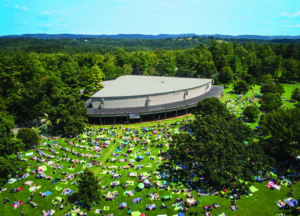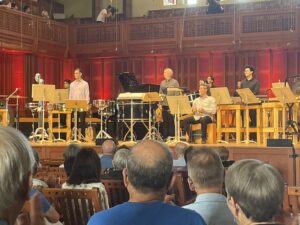2025 Festival of Contemporary Music at Tanglewood
2025 Festival of Contemporary Music at Tanglewood – July 24 – July 28, 2025

Every summer since 1964, the Tanglewood Music Center presents its Festival of Contemporary Music. According to Tanglewood’s materials:
The Festival of Contemporary Music (FCM) is one of the world’s premier showcases for works from the current musical landscape and landmark pieces from the new music vanguard of the 20th century. FCM affords Tanglewood Music Center Fellows the opportunity to explore unfamiliar repertoire and experience the value of direct collaboration with living composers.
Over the four FCM concerts (of the total of six) I heard carefully honed performances by the Tanglewood Fellows, Fromme players and the Mexican percussion quartet Tambuco.
Gabriela Ortiz is the director of FCM this year, the latest in the many high notes that the Mexican composer is enjoying. In the past season, she was composer in residence at Carnegie Hall, Curtis Institute, and Orquesta Sinfónica de Castilla y León; her commissioned works were premiered at New York and Los Angeles Philharmonics, and she won three Grammy awards.
Ortiz’s FCM programming traced the lineage of Mexican composers from Chavez to Lavista to Ortiz herself and to her student Diana Syrse, showed off the versatile talents of the Mexico-based percussion ensemble Tambuco and the incredible capacity of the Tanglewood Fellows to learn and perfect carefully honed performances of a mountain of new music.
Two beefs: Each program ran at least 25% longer than its stated duration. Each was densely programmed, and the ultralong set changes between each piece (often involving dozens of percussion instruments) were not accounted for in the production schedule. Nor were the often-lengthy introductions by Ortiz.
And, rather than presenting a spectrum of works by a range of composers, Ortiz programmed a great deal of her own music with a smattering of other works to provide context. This was in contrast to previous years in which a broader survey of music was presented.
Ortiz’s music is high-quality and thoughtful, employing interesting sounds and techniques, rhythms and sonorities, often telling a story in vivid colors and gestures. But pretty much every piece wore out its welcome, going on long after I felt it should have ended, without bringing in new ideas or furthering the experience of the piece.

Which brought to mind a question that nags me from time to time – why don’t composers have editors? Authors of books have them. Journalists have them. But no one seems to be telling a composer, “Draw a double bar already, would ya?” Come to think of it, it may be the test of time that serves this purpose. There’s a lot of music written over the past 500 years that is justly neglected. Conversely, there’s good reason that many war horses in the canon have endured. It’s collective taste making, standing the test of time.
The program on July 25, “Mexico, Cuba, the U.S., and One Hundred Years of Percussion” featured, predictably, a barrage of percussion, and in every piece at least one unusual instrument was on stage. In Ortiz’s Rio de las Mariposas for two harps and steel drum, the disparate instruments blended surprisingly well. The glass harmonica gave Mario Lavista’s Musicas de Cristal a soundscape all its own. The soft slow music was enhanced by the ambient rustle of trees outside Ozawa Hall. Amadeo Roldán’s Rítmica V and Rítmica VI included a cascade of diverse instruments, the most unusual of which was a marimbula, a cross between a giant mbira (African thumb piano) and a cajón (a wooden box which the percussionist slaps with their hand). Hearing the mechanical sirens in Edgard Varese’s landmark Ionisation, was the peak of a memorable performance of that iconic 20th century work.
On July 26, the program “Music of Migration and Exile” included music by Ortiz and the Mexican-American composer Ricardo Zohn-Muldoon. This program, as all the others that I heard at the FCM, were marked by truly spectacular performances by the fellows. All around they play like much more seasoned pros, and with an enthusiasm and bravado that more experienced hands sometimes lack.
Zohn-Muldoon’s Suite from Comala is an extract of a larger work based on Pedro Páramo, a classic Mexican novella by Juan Rulfo. Zohn-Muldoon added guitar to this score for Pierrot ensemble plus percussion and guitar. The combination worked especially well in this alluring work, as the guitar sometimes aligned with the strings, and at other times with the percussion.
In addition to the programs I detailed above, the festival highlighted the talents of the American composers Ellen Reid and Gabriela Smith. It was great to hear some concert music from Mexico that doesn’t often get to U.S. stages. And there’s nothing like getting to revel in the sounds of contemporary concert music for four days, especially in the picturesque environs of the Tanglewood Music Center.